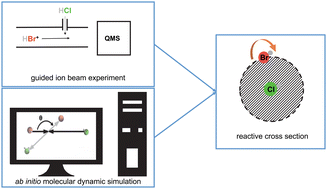Ion–molecule reactions in the HBr+ + HCl (DCl) system: a combined experimental and theoretical study†
Abstract
Reactions in the system HBr+ + HCl (DCl) were investigated inside a guided ion-beam apparatus under single-collision conditions. In the HBr+ + HCl system, the proton transfer (PTHCl) and charge transfer (CT) are observable. In the HBr+ + DCl system, proton transfer (PTDCl) and deuterium abstraction (DA) are accessible. The cross sections for all reaction channels were measured as a function of the collision energy Ecm and of the rotational energy Erot of the ion. The rotationally state-selective formation of the ionic species was realized by resonance-enhanced multiphoton ionization (REMPI). As expected, the PT-channels are exothermic, and the cross section decreases with increasing collision energy for both PTHCl and PTDCl. The cross section for DA also decreases with an increasing Ec.m.. In the case of a considerably endothermic CT-channel, the reaction efficiency increases with increasing collision energy but has an overall much smaller cross sections compared to PT and DA reactions. Both PT-reactions are hindered by ion rotation, whereas DA is independent of Erot. The CT-channel shows a rotational enhancement near the thermochemical threshold. The experiment is complemented by theory, using ab initio molecular dynamics (AIMD, also known as direct dynamics) simulations and taking the rotational enhancement of HBr+ into account. The simulations show good agreement with the experimental results. The cross section of PTHCl decreases with an increase of the rotational energy. Furthermore, the absolute cross sections are in the same order of magnitude. The CT channel shows no reactions in the simulation.



 Please wait while we load your content...
Please wait while we load your content...